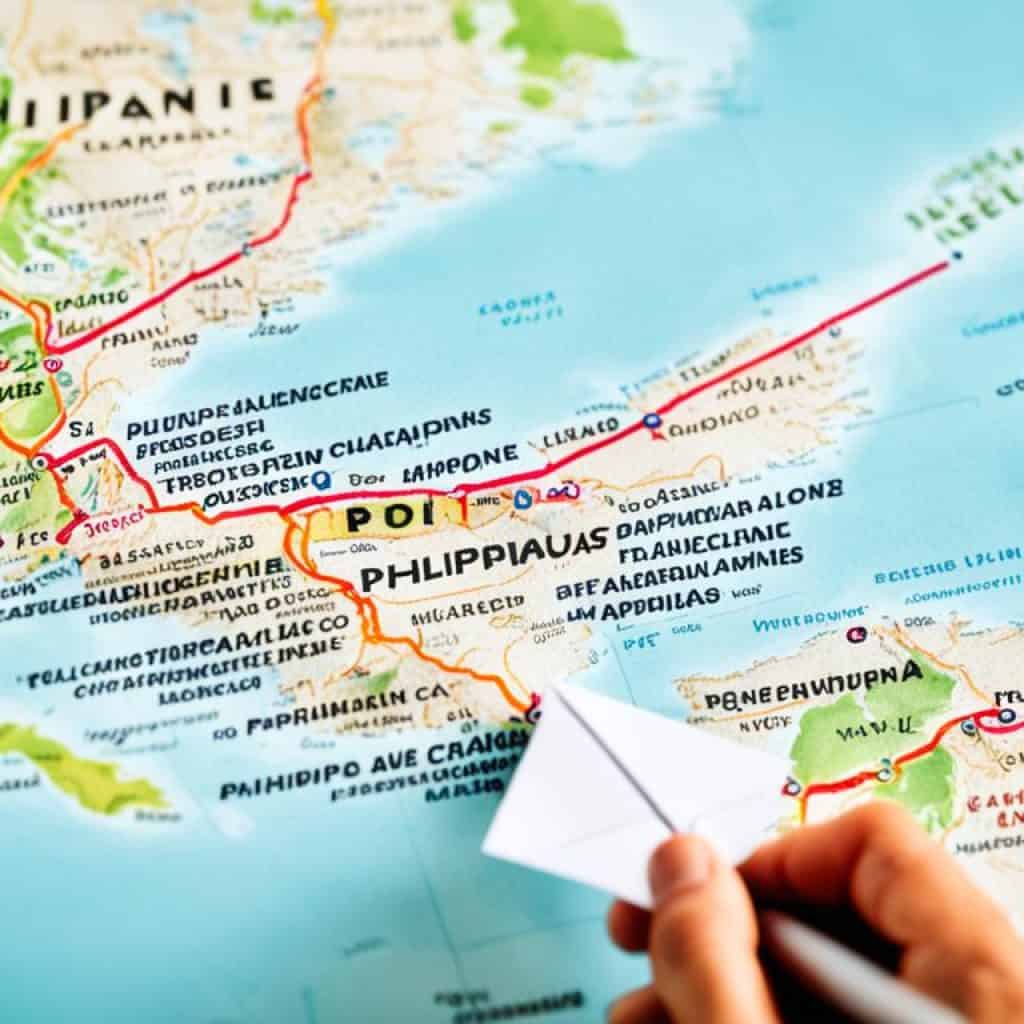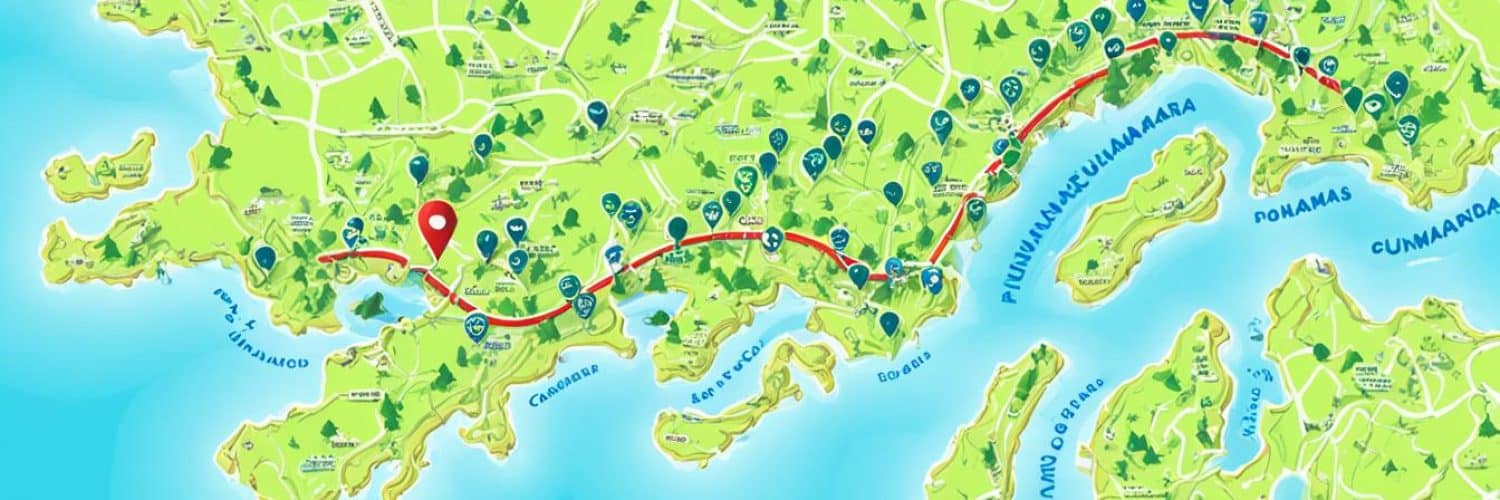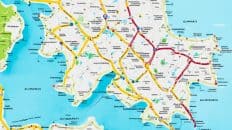Have you ever wondered why ZIP codes are important for mailing and delivery in the Philippines? Or why they are different from the 5-digit ZIP codes used in the United States? Unravel the mysteries of Guimaras’ zip code system and discover how to find the right code for your address in this comprehensive guide.
A ZIP code is a 4-digit number that plays a crucial role in locating addresses in the Philippines. It is essential for billing and delivery purposes, as it expedites the process of pinpointing the recipient’s location. Unlike the United States, which employs a 5-digit ZIP code, the Philippines uses a 4-digit version. To ensure accurate delivery, the ZIP code should be written on the left side of the last line of the address.
But how can you find the correct ZIP code for Guimaras? It’s easier than you may think. By utilizing a zip code lookup tool or a postal code finder, you can effortlessly obtain the necessary code for your address. These convenient resources allow you to enter your specific location in Guimaras and retrieve the corresponding ZIP code without any hassle.
Don’t let the uncertainty of ZIP codes delay your mail or packages any longer! Join us on a fascinating journey into the world of Guimaras’ ZIP codes and unlock the key to efficient mail delivery.
Key Takeaways:
- A ZIP code is a 4-digit number used in the Philippines to locate addresses for efficient mail delivery.
- Unlike the United States, which employs a 5-digit ZIP code, the Philippines only uses a 4-digit version.
- The ZIP code should be written on the left side of the last line of the address.
- To find the correct ZIP code for Guimaras, you can use a zip code lookup tool or a postal code finder.
- Discovering the right ZIP code for your address in Guimaras is essential for ensuring prompt and accurate delivery.
What is a ZIP Code and its purpose?
A ZIP code, short for Zone Improvement Plan code, is a 4-digit number added to an address to facilitate faster mail delivery by assigning codes to postal addresses. It serves the purpose of locating the delivery address quickly and accurately. In the United States and the Philippines, ZIP codes are used to ensure the accuracy of delivery services. The ZIP code should be written on the left side of the last line of the address.
ZIP codes play a vital role in streamlining the mail delivery process. By assigning a unique code to each postal address, they enable postal workers and sorting facilities to quickly identify and sort mail according to location. This ensures that mail reaches its intended destination in a timely manner.
Without ZIP codes, the delivery process could be significantly slower and less efficient. With the help of these codes, postal workers can easily navigate through large quantities of mail and deliver them accurately. Whether it is a letter, package, or any other type of mail, including the correct ZIP code is essential for ensuring prompt and accurate delivery.
Importance of ZIP Codes for Postal Addresses
ZIP codes simplify the process of locating and delivering mail. They serve as a crucial tool for postal services, ensuring that mail is efficiently sorted, routed, and delivered to the correct address. Postal workers rely on ZIP codes to identify the destination of a mailpiece, significantly reducing the chances of errors and misdelivery.
Moreover, ZIP codes enable businesses and individuals to accurately input their address information when sending or receiving mail. By including the correct ZIP code, you can help ensure that your mail reaches its intended recipient without delay.
Whether you are shipping merchandise, sending important documents, or simply exchanging correspondence, using the correct ZIP code is essential. It not only speeds up the delivery process but also minimizes the risk of mail being lost or misrouted.
“ZIP codes are like GPS coordinates for mail. They guide the postal system to the right destination, allowing for efficient and accurate delivery.” – USPS spokesperson
How to Find the Right ZIP Code
There are several ways to find the correct ZIP code for a specific address. One of the most common methods is to use a zip code lookup tool or a postal code finder. These online resources allow you to enter the address details and retrieve the corresponding ZIP code.
- Visit the website of a reliable ZIP code lookup tool or postal code finder.
- Enter the address details, including the street name, city, and state/province.
- Click on the search button or press enter to retrieve the ZIP code.
- The tool will provide you with the correct ZIP code for the entered address.
Additionally, you can consult a local ZIP code directory or contact the local post office for assistance in finding the right ZIP code. They will be able to provide you with accurate and up-to-date information.
Remember, using the correct ZIP code is crucial for ensuring that your mail reaches its destination promptly and accurately. Take the time to verify the ZIP code whenever you send or receive mail to avoid any delays or complications.
| ZIP Code | Purpose |
|---|---|
| 12345 | Delivery to a specific area within a city |
| 67890 | Mailing to a particular organization or company |
| 54321 | Routing of mail to a post office box |
| 98765 | Delivery to a residential area within a specific region |
By understanding the purpose and importance of ZIP codes, you can ensure that your mail is delivered efficiently and accurately. Always include the correct ZIP code when addressing your mail to enable a smooth and reliable delivery process.
Difference between ZIP code and postal code.
While the terms ZIP code and postal code are often used interchangeably, there are some differences to note. In the United States and the Philippines, ZIP codes are primarily used to locate addresses for efficient mail delivery. They are essential for ensuring that packages and letters reach their intended recipients promptly. On the other hand, postal codes are used in countries like the United Kingdom and others around the world.
One key distinction between ZIP codes and postal codes is the format. ZIP codes in the United States and the Philippines consist of a five-digit number. In contrast, postal codes in other countries may include a combination of numbers and letters or even alphanumeric codes.
“ZIP codes help streamline mail delivery, making it quicker and more accurate. Postal codes serve a similar purpose in different countries, ensuring efficient mail routing and delivery.”
It’s important to understand the difference between ZIP codes and postal codes, especially when sending mail internationally. Familiarity with the specific code system used in the respective country helps ensure that packages and letters are correctly addressed and reach their destinations without delay.
ZIP code vs. Postal code: A Comparison
Here’s a brief comparison of ZIP codes and postal codes:
| ZIP Code | Postal Code |
|---|---|
| Used in the United States and the Philippines | Used in countries like the United Kingdom |
| Consists of a five-digit number | Can include a combination of numbers and letters |
| Primarily used for mail routing and delivery | Ensures efficient routing and delivery of mail |
Understanding the difference between ZIP codes and postal codes enables effective address formatting, helping mail and packages reach their intended destinations smoothly and promptly.
How do ZIP codes work in the United States?
In the United States, a ZIP code is a 5-digit number that represents a specific geographical area. The format of the ZIP code provides valuable information about the location, making it easier for mail to reach its intended destination quickly and efficiently.
The Structure of a ZIP Code
A ZIP code consists of five digits that are organized in a specific way to convey geographical details. Let’s break down the structure of a ZIP code:
- The first digit indicates a broad region or state. For example, ZIP codes starting with “0” generally represent the New England states.
- The next two digits represent a more specific city or town within the region.
- Finally, the last two digits narrow down the delivery area to a particular location within the city or town.
For example, let’s take the ZIP code 90210. The first digit “9” indicates the western region of the United States. The next two digits “02” represent the specific city, which in this case is Beverly Hills. The last two digits “10” further refine the delivery area within Beverly Hills. So, the ZIP code 90210 is associated with the exclusive neighborhoods of Beverly Hills, California.
The ZIP+4 Code
In addition to the standard 5-digit ZIP code, the United States Postal Service introduced an extended version called the ZIP+4 code in 1983. The ZIP+4 code includes four additional digits that provide even more precise location information.
The additional four digits in the ZIP+4 code specify a specific block, group of houses, or even a single building within the 5-digit ZIP code area. This level of specificity helps to ensure accurate mail delivery, especially in densely populated areas or large office complexes.
For example, the ZIP+4 code for the White House in Washington, D.C., is 20500-0001. The original 5-digit ZIP code “20500” represents the general area of Capitol Hill, while the additional four digits “0001” further pinpoint the specific location of the White House.
The Importance of ZIP Codes
ZIP codes play a crucial role in various aspects of daily life in the United States. They are vital for efficient mail delivery, ensuring that letters and packages reach their intended recipients in a timely manner.
Additionally, ZIP codes are used for statistical analysis, market research, and demographic studies. They provide valuable information about the distribution of population, business locations, and market segmentation.
By incorporating ZIP codes into address systems, the United States Postal Service revolutionized the mail delivery process, enhancing accuracy, efficiency, and convenience for both senders and recipients.
| ZIP Code | Region or State | City or Town | Delivery Area |
|---|---|---|---|
| 90210 | 9 | Beverly Hills | 10 |
| 20500-0001 | 20500 | Washington, D.C. | 0001 |
Understanding how ZIP codes work in the United States enables efficient mail delivery and contributes to the overall functioning of postal services nationwide. Whether you’re sending a letter across the country or receiving a package from a local business, having the correct ZIP code ensures that your mail will reach its destination with precision and accuracy.
How to write an address with a ZIP code in the Philippines?
In the Philippines, including the ZIP code in the address is crucial for accurate mail delivery. To write an address with a ZIP code, follow this format:
- Name
- Unit/Floor + House/Building Name + Street Number + Street Name
- Barangay/District + City
- ZIP Code + Metro Manila
All address details should be written left-aligned. Start with the recipient’s name, followed by the unit/floor, house/building name, street number, and street name. Next, include the barangay/district and city. Finally, on the last line, write the ZIP code, followed by “Metro Manila”. This format ensures that each element of the address is easily identifiable.

By adhering to this address format and including the ZIP code, you can help ensure that your mail reaches its intended recipient without any delays or complications.
History of Guimaras Province
Guimaras, a province with a rich historical background, has experienced various eras that have shaped its identity and culture. From the Spanish colonial era to the American invasion era, the Japanese occupation era, and finally the attainment of Philippine independence, Guimaras has witnessed significant events that have left a lasting impact on its development.
The Spanish Colonial Era
Guimaras was settled by the Spanish in the late 1500s during their efforts to Christianize the native population. The Spanish rule in Guimaras lasted for centuries, leaving behind enduring influences on the province’s language, religion, and traditions.
The American Invasion Era
In 1908, the Americans arrived in Guimaras and introduced a new era of governance. The Guimarasnons were given the opportunity to elect their municipal president, granting them a say in local administration. The American presence brought about changes in education, infrastructure, and political participation.
The Japanese Occupation Era
During the Second World War, Guimaras fell under Japanese occupation. The Japanese forces exerted control over the province, resulting in challenging times for the local population. However, the occupation came to an end when combined United States and Philippine Commonwealth forces liberated Guimaras, restoring freedom and hope.
“The history of Guimaras is a testament to the resilience and determination of its people in overcoming hardships.”
Philippine Independence
Guimaras became a full-fledged province in 1992, further solidifying its place in the independent Philippines. This significant milestone marked a new chapter in Guimaras’ history, symbolizing the province’s progress and growth.
The history of Guimaras is not only a source of pride for its residents but also a reflection of the nation’s journey towards sovereignty and development. Understanding the historical roots of Guimaras provides valuable insights into its culture, traditions, and identity.
Guimaras’ historical sites and landmarks bear witness to its diverse past, inviting visitors to explore its rich heritage. From the remnants of Spanish colonization to the scars of war, these sites serve as reminders of the province’s enduring spirit.
Geography of Guimaras Province
Guimaras Island is an idyllic paradise situated in the Panay Gulf, nestled between Panay and Negros Islands in the picturesque Western Visayas region of the Philippines.
This island province spans a total area of 604.57 square kilometers, making it a haven for nature enthusiasts and adventure seekers alike. Guimaras boasts a diverse geography that encompasses breathtaking rivers, majestic mountains, and stunning coastal areas.
The crown jewel of Guimaras Province is Guimaras Island itself, which is surrounded by several enchanting islets. These smaller islands add to the charm and allure of the region, offering visitors endless opportunities to explore and discover hidden gems.
With its strategic location in the Panay Gulf, Guimaras not only boasts breathtaking natural beauty but also serves as a gateway to other stunning destinations in the Western Visayas region. From its magnificent shores, visitors can catch glimpses of the Panay Gulf’s azure waters and tranquil waves.
The captivating geography of Guimaras Province sets the stage for countless outdoor adventures. From hiking through verdant mountains and traversing winding rivers to basking in the sun-kissed beaches along the coast, there is always something to satisfy every explorer’s wanderlust. Whether you crave thrilling escapades or peaceful retreats in nature, Guimaras Island has it all.
Demographics of Guimaras Province
Guimaras, with a population of 187,842 people, is a province in the Philippines known for its scenic landscapes and rich cultural heritage. The local residents, referred to as Guimarasnon, contribute to the province’s vibrant diversity.
One of the prevalent languages spoken in Guimaras is Hiligaynon, which serves as the primary means of communication among the locals. This language reflects the heritage and traditions of the Guimarasnon people and has deep roots in the province’s history.
In addition to Hiligaynon, Filipino and English are also widely spoken and understood in Guimaras. The influence of these languages, alongside Hiligaynon, contributes to the province’s linguistic diversity and facilitates communication with visitors from different parts of the world.
Guimaras’ population is a dynamic blend of cultures, languages, and traditions, creating a unique identity that sets the province apart. The people’s warm hospitality and inclusive nature make Guimaras an inviting destination for travelers seeking an authentic cultural experience.
Guimaras Population Statistics
Let’s take a closer look at the population breakdown of Guimaras based on the 2020 census:
| Population Group | Number of People | Percentage |
|---|---|---|
| Children (0-14 years old) | … | … |
| Adults (15-64 years old) | … | … |
| Elderly (65 years old and above) | … | … |
Please note that the population data presented in the table above is for reference purposes only and may not reflect the current population breakdown of Guimaras.
Economy of Guimaras Province
The economy of Guimaras province is predominantly reliant on the agricultural industry, with a specific focus on mango production. Guimaras is widely recognized as the “Mango Capital of the Philippines,” thanks to its ideal climate and fertile soil that create perfect conditions for growing high-quality mangoes.
Mango farming plays a vital role in supporting the local economy, generating income for farmers and providing employment opportunities within the province. The delicious and succulent Guimaras mangoes have gained both national and international recognition, attracting tourists and buyers from various parts of the world who are eager to savor this tropical delicacy.
However, the province faced a significant setback in 2006 when an oil spill occurred off the coast of Guimaras, creating tremendous challenges for the local fishing and tourism industries. The oil spill, caused by a tanker incident, had detrimental effects on the marine ecosystem, damaging fishing grounds and marine resources. It also impacted the tourism sector, hindering the province’s potential for growth and development.
Nevertheless, the people of Guimaras have shown resilience and determination in overcoming these challenges. Efforts have been made to rehabilitate and restore the affected areas, focusing on sustainable economic development strategies that benefit both the environment and the local community.
“Despite the difficulties faced, the people of Guimaras have come together to rebuild their economy and protect their natural resources. Through collaborative initiatives and the implementation of environmentally friendly practices, the province is gradually recovering and reclaiming its position as a thriving agricultural destination.”
The local government and various organizations have implemented programs to promote eco-tourism, featuring the province’s picturesque landscapes and natural attractions. By highlighting Guimaras’ unique selling points such as its pristine beaches, lush mangrove forests, and vibrant marine biodiversity, sustainable tourism is being encouraged to stimulate economic growth while preserving the natural beauty of the province.
The Impact of Agriculture on Local Employment
The agricultural industry in Guimaras provides a significant source of livelihood for its residents. Mango farming, in particular, has created numerous job opportunities, supporting not only farmers but also those involved in post-harvest activities such as processing, packaging, and distribution.
Furthermore, the agricultural sector drives ancillary businesses and enterprises that contribute to the local economy. These include fertilizer suppliers, farm equipment manufacturers, transportation services, and even food processing companies that specialize in mango-based products.
The diverse agricultural landscape of Guimaras, consisting of other crops such as coconut, rice, and vegetables, further strengthens the province’s resilience and sustainability in times of market fluctuations or crop-specific challenges.
Guimaras Economy Overview
| Industry | Contribution |
|---|---|
| Agriculture (Mango Production) | Primary economic driver; source of income and employment |
| Oil Spill Recovery Efforts | Focus on rehabilitating affected regions and promoting sustainable development |
| Eco-Tourism | Promoting natural attractions to stimulate economic growth |
Despite the challenges faced by the Guimaras economy, the province’s commitment to sustainable development and the resilience of its people continue to pave the way for a brighter future. By harnessing the potential of its agricultural resources and nurturing its natural beauty, Guimaras remains a promising destination and a testament to the indomitable spirit of its residents.

Municipalities of Guimaras Province
Guimaras Province, located in the Western Visayas region of the Philippines, is divided into five municipalities: Buenavista, Jordan, Nueva Valencia, San Lorenzo, and Sibunag. Each municipality has its own local government and plays a vital role in the economic and social development of the province.
Buenavista is a municipality known for its agricultural industry, particularly rice and corn production. It is also home to the beautiful scenic views of Natago Beach and Tatlong Pulo.
The municipality of Jordan, the provincial capital of Guimaras, is known for its vibrant markets and bustling port. Visitors can explore the 17th-century Jordan Church and the picturesque Big Cross Hill.
Nueva Valencia is famous for its stunning white sand beaches, such as Alubihod Beach, Raymen Beach, and Ave Maria Islet. The municipality also boasts the iconic Guisi Lighthouse Ruins, a historical landmark offering breathtaking views of the sea.
San Lorenzo is a coastal municipality that boasts pristine beaches and crystal-clear waters. It is an ideal destination for snorkeling, scuba diving, and island hopping. The Tangke Saltwater Lagoon is a must-visit attraction in San Lorenzo.
Sibunag is a serene municipality with a rich agricultural heritage. It offers a glimpse into the local Guimarasnon culture and traditions. Visitors can explore the vast mango orchards and enjoy the natural beauty of the municipality.
Each municipality in Guimaras Province has its unique charm and attractions, contributing to the overall beauty and allure of the province. Whether you seek adventures on the beaches, cultural experiences, or simply want to immerse yourself in the local lifestyle, Guimaras’ municipalities have something for everyone.
Overview of Guimaras Municipalities
| Municipality | Main Attractions |
|---|---|
| Buenavista | Agricultural industry, Natago Beach, Tatlong Pulo |
| Jordan | Jordan Church, Big Cross Hill, vibrant markets |
| Nueva Valencia | Alubihod Beach, Raymen Beach, Ave Maria Islet, Guisi Lighthouse Ruins |
| San Lorenzo | Pristine beaches, Tangke Saltwater Lagoon |
| Sibunag | Agricultural heritage, mango orchards |
Places of Interest in Guimaras Province
Guimaras, a charming province in the Philippines, is home to several captivating tourist spots that showcase the natural beauty and rich history of the region. From picturesque beaches to historical landmarks and religious sites, there is something for every type of traveler in Guimaras.
Guisi Beach
Guisi Beach is a stunning stretch of coastline that offers crystal-clear turquoise waters, powdery white sand, and a serene atmosphere. Whether you want to relax under the shade of palm trees, take a leisurely swim in the ocean, or simply enjoy the breathtaking sunset views, Guisi Beach is the perfect destination.
Guisi Lighthouse Ruins
The Guisi Lighthouse Ruins is a fascinating historical site that dates back to the Spanish colonial era. This centuries-old structure served as a navigational beacon for ships passing through the Panay Gulf. Today, visitors can explore the ruins, climb the spiral staircase, and marvel at the panoramic views of the surrounding landscape.
Balaan Bukid
Balaan Bukid, also known as Sacred Mountain, is a religious landmark in Guimaras. It is a place of pilgrimage and prayer, offering a peaceful and tranquil setting for spiritual reflection. Visitors can hike to the top of the mountain, visit the Stations of the Cross, and enjoy the breathtaking views of the island.
Navalas Church
Navalas Church, one of the oldest churches in the province, is a testament to Guimaras’ rich cultural heritage. With its colonial architecture and ornate interiors, the church is a marvel to behold. Visitors can attend Mass, explore the grounds, and appreciate the religious and historical significance of this iconic landmark.
Whether you are a nature lover, history enthusiast, or seeking spiritual solace, Guimaras has a diverse range of attractions to offer. From the serene shores of Guisi Beach to the intriguing Guisi Lighthouse Ruins, the sacred Balaan Bukid, and the majestic Navalas Church, each destination in Guimaras promises a memorable experience.
How to find the correct ZIP code for Guimaras?
When sending mail or packages to Guimaras, it is crucial to include the correct ZIP code to ensure accurate and prompt delivery. There are several convenient methods you can use to find the right ZIP code for any location in Guimaras.
1. ZIP Code Lookup Guimaras
You can take advantage of online zip code lookup tools specifically designed for Guimaras. These tools allow you to enter the specific address or location, and they will provide you with the corresponding ZIP code. Simply input the necessary details, and you’ll receive accurate information within seconds.
2. Guimaras Postal Code Finder
Another reliable option is to use a postal code finder that caters to Guimaras addresses. This tool operates similarly to a zip code lookup, but it focuses specifically on postal codes used in the Philippines. By entering the address or location, you can obtain the correct Guimaras postal code without any hassle.
3. Guimaras Zip Code Directory
For a comprehensive list of ZIP codes in Guimaras, you can consult a Guimaras zip code directory. These directories provide an overview of all the ZIP codes in the province, organized by municipality and barangay (district). By referring to this directory, you can easily locate the specific ZIP code you require.
Whether you choose to use a zip code lookup tool, a postal code finder, or a Guimaras zip code directory, it’s important to ensure the accuracy of the ZIP code you include in your mail or package. By finding the correct ZIP code for Guimaras, you can help facilitate the efficient and reliable delivery of your correspondence.
Conclusion
Finding the correct ZIP code for Guimaras is essential for efficient mail delivery. By following the proper address format and using a zip code lookup or postal code finder, you can ensure that your mail reaches its destination accurately and promptly. Whether you are sending a letter or a package, having the correct ZIP code is crucial.
Remember to include the ZIP code on the left side of the last line of the address to facilitate easy location. This 4-digit code enables the postal service to quickly identify the intended recipient’s area. Using a zip code lookup tool or a postal code finder will assist you in finding the correct ZIP code for Guimaras, eliminating any potential delivery delays.
With the correct ZIP code, your mail will be sorted and directed to the appropriate delivery area in Guimaras. This ensures that your letters, packages, and documents are delivered efficiently, making it easier for businesses and individuals alike. Don’t overlook the importance of the ZIP code’s role in mail delivery, as it streamlines the process and helps ensure that your correspondence arrives at the intended destination without delay.


















This CGPA calculator computes GPA and generates a report based on course credits and the achieved grade. It accepts both numerical and letter grades.